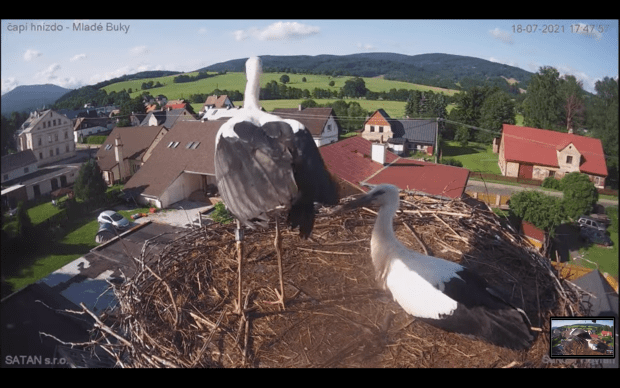A lady in Manitoba is trying to figure out if anyone has ever seen what is happening at her house. Keely calls it a ‘strange domestic situation’. The nest has 3 robin chicks. The couple taking are of them are a Robin and a Sparrow. Both of the birds sit on the nest, feed the chicks, clean up the nestlings pop sacs, as well as standing guard. The couple often sit next to one another on the telephone line. Keely finds it fascinating. Have you ever seen such an adoption?


The little sparrow’s head almost fits into the mouth of the Robin nestling when he comes to feed it.

The proud couple!

In Montana, there has been a second life given to an Osprey chick. Ospreys are known to be very good foster parents. The researchers at the Montana Osprey Project have been busy. They are trying something very complicated called cross-fostering.
Yesterday they found a second chick that was found tangled in baling twine at the Steinbrenner’s House. It was an only chick. If they removed it to care the parents might leave for their migration. At the same time, the original chick that was taken to care for baling twine entanglement was ready to go back to its nest. That chick’s name was Kona. But its older sibling had fledged and the parents weren’t at the nest much.
So Kona was put in the nest at the Steinbrenner’s house. The plan is to keep the parent’s busy taking care of Kona until their chick is out of rehab in a week or so. Then they will have two chicks to look after.
So how did it work? Kona was placed in the Steinbrenner nest and she begin flapping and wingersizing. At the same time, the person with the Montana Osprey Project put two trout in the nest with her.

The female landed on the nest and there was no aggression spotted. The female took one of the trout and flew to eat it. Kona began eating the other trout. Meanwhile, the male arrived with a fish which, when seeing everyone eating, he took off to eat himself. The female went back to the nest and both her and Kona are eating on the fish. Another great intervention to help the birds. Smile. It is fantastic! The latest news is that all is well.
Those stories just make you feel really good!
Other Nest News. If you are needing to see some Bald Eagles, Harriet and M15 are back hanging out at the SWFlorida Bald Eagle Nest on the Pritchett Property in Fort Myers. Samson was seen on the NE Florida Bald Eagle nest and that streaming cam is up and running after its annual maintenance. The Collins Marsh Osprey is looking good.

The Achieva Osprey nest has had an adult visitor today. Rumours have it that it could be Jack, the female, just checking on his territory. Blue 463 otherwise known as Tiny Little Tot on the Foulshaw Moss Nest has become the dominant bird on the nest – wow. A mighty third hatch. She was there today waiting for a fish delivery and looking good.

Zenit continues to grow and stay close to the nest for prey deliveries. This Golden Eagle juvenile has really grown! The Asociata Wild Bucovina that sponsors this nest have received enough donations to have two cameras operating next season. Congratulations to them.

It has been a really uplifting day in Bird World. Thank you so much for joining me. Take care.
Thank you to the following for their streaming cams where I took my screen shots: Asociata Wild Bucovina, Cumbria Wildlife Trust and Foulshaw Moss Osprey Cam, and the Collins Marsh Osprey Nest Cam. Thanks also to Keely on the Manitoba Birding & Photography FB Group for allowing us to share her story and to the Montana Osprey Project FB Page.













































































